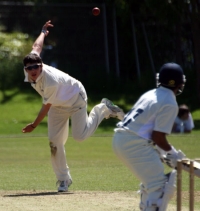|
 One of the fastest ways to gain an edge over the opposition is to improve your fitness because so few sides work on it. One of the fastest ways to gain an edge over the opposition is to improve your fitness because so few sides work on it.
But you don't want to waste your valuable time on fitness work that's useless on the pitch on matchday.
So when I heard Scottish club team Watsonians were making cricket-specific speed and endurance a big focus for the coming season I spoke to the man charged with the job, Mike Legget, to find out how they are doing it.
Mike plays for Watsonians and knows his training inside out as a qualified Strength Coach and Sport Science student.
Here is what we discussed.
How do you set up your training sessions?
We have normal nets as any club do, and we also have a fitness specific session once a week which is totally separate. The advantage of this is so we can focus on physical skills rather than technical ones.
For example a lot of people have never been taught how to run and turn so we want to take it back to basics and build up that base.
So, it doesn't matter whether you can catch or stop a cricket ball or not. I'm more concerned about how you get in position in the first place like running as fast as possible or how fast you are reacting. So while they are separate, they are related to the final skill as well.
Eventually in the summer when the weather is better we will be combining cricket skill and fitness sessions. We will put speed drills into warm ups and reiterating technique during fielding drills.
What you are saying is that it's not about building up a sweat then?
That's right, cricket is not really that type of sport. It's about learning how to move efficiently: Running, accelerating, changing direction and reacting quickly.
What the coach or captain has to realise is that there is no point doing endless shuttle runs to increase the ability to run a quick single. To get faster you have to run quick singles. "Beasting" people is a waste of time. You are never going to be able to run at top speed if you are exhausted and it's not how cricket is played.
How much can a cricket coach do to teach that to senior players?
Anyone can learn the basics of moving correctly via certain drills. The coach doesn't need to know every technical point inside out. Alright, it might not be perfect but the fact they are doing anything will make them better.
What are the key things to look for when coaching movement that's cricket specific?
With running forwards the first thing is foot contact. You are looking for players to land on the balls of the feet rather than the heels.
It's also important to have high knees and bring the heel up towards the bum at the same time, which is called heel recovery.
Make sure the arms don't flay around too.
When you are changing direction the key is to decelerate and accelerate away as fast as possible by trying to do it in one smooth movement rather than a slow turn like the QE2 turning.
One good drill is to set down 3 cones, one to start, one to decelerate and one to have stopped totally. The aim of the drill is to sprint fast to the second cone and have stopped dead by the third cone. Move the cones closer together to speed up the deceleration.
You can add a catch to the end to make sure the player is in the right position.
What's the difference when you add pads?
Your running style changes and you slow down. Pads and a helmet make you heavier and holding a bat means you can't swing your arms as much. That means it's important to run in full batting gear once you have done drills without them on.
But the principles of running stay the same.
What does a typical cricket specific fitness session look like?
We start off with a warm up that includes dynamic stretching like lunges, hip mobility and those kinds of movements. We also work on technical drills for running in the warm up. We gradually increase the speed of these drills until we are up to almost full running speed.
The main part of the session then focuses on a particular skill like accelerating, changing direction or whatever. We do some drills that for the technical side then bring a ball in to make it more competitive.
I use wall drills and to teach the right position for acceleration. I also use march drills like the A March to learn the right posture and foot position.
I use mini hurdles to teach the players to run sideways with high knees and to push off with the inside of the foot.
We add reaction work in by getting players into pairs about 5m apart. One holds a tennis ball up and drops it. The second player has to catch it before it bounces a second time. You can this drill from sideways, face on or even backwards.
We finish with some speed endurance work with shuttle runs. This is usually in singles to focus on speed. We do make sure there is plenty of rest to recover in the same way as you would out in the middle.
I try to make it fun and include lots of competitions between players.
How should you hold the bat when you run?
I've not seen any research into this so I'm not sure.
In my mind, the key thing to look out for is to make sure the bat doesn't fight the body when you run. A good method is to hold the bat across your body in both hands but do whatever is comfortable.
What about turning for another run: Should you turn facing the ball or should you turn with your stronger leg and disregard where the ball is?
I would watch the ball and avoid turning blind.
We make sure we train both legs even if it isn't quite as fast because you don't want cause confusion and run outs. Ideally if you train both legs there shouldn't be much difference anyway.
Do you do any strength training with the team?
I don't get to control the strength training part because we only have one session a week. Ideally I would have 2-3 sessions a week working on all aspects of fitness. Strength is important because the stronger you are the more force you can produce and so you can do everything faster.
But because we are an amateur team we can't all train in the gym together. I do write programmes for players and help them with the techniques if they need it. Others like to do their own thing and as long as they are doing something that's OK with me, even if it's not perfect.
We do some core work with the players in the sessions to get something in. We either use bodyweight exercises or bring in some medicine balls for training trunk rotation.
Watsonians are an Edinburgh cricket club based in Myreside. They play in the Scottish Cricket League Premier Division. You can find them on facebook and twitter.
Discuss this article with other subscribers
|

.jpg)




.jpg)


